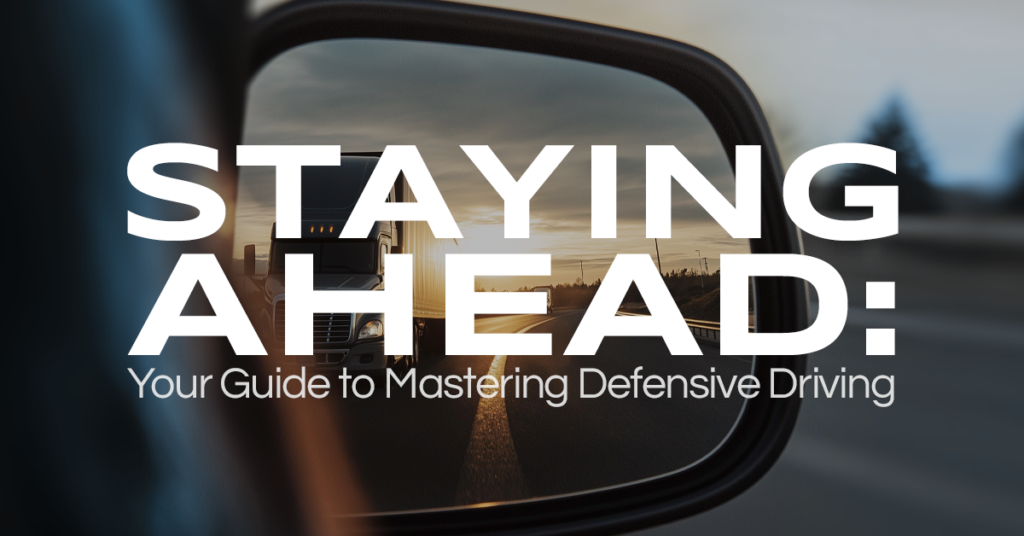
🚛 Stay Sharp: Defensive Driving Skills Every Driver Needs
Staying safe on the road isn’t just about knowing how to drive—it’s about being prepared for what others might do. For truckers and logistics professionals, mastering defensive driving techniques can make the difference between a smooth journey and an unexpected incident. This article breaks down the essential defensive driving tips that every driver should have in their toolbox. From managing blind spots to adapting to weather conditions, we’ll explore practical strategies to keep you safe and confident behind the wheel. Let’s dive into the details and make sure your next trip is as safe as it can be.
🚦 Top 10 Defensive Driving Tips for Staying Safe
Defensive driving is about being proactive and staying alert, helping you avoid potential dangers on the road before they happen. It’s not just about your driving—it’s about reading the road, predicting other drivers’ behavior, and adjusting your actions to keep yourself and others safe. Here are ten essential defensive driving tips, backed by science, to ensure you stay safe no matter where you’re driving.
- 🛑 Maintain a Safe Following Distance
- Keeping a safe distance from the vehicle ahead is crucial for giving yourself enough time to react. The “three-second rule” provides a buffer zone—if the car in front stops suddenly, this space helps you brake smoothly without slamming on your brakes, which reduces the risk of rear-end collisions. In poor weather, like rain or snow, this distance should be increased to five or six seconds to compensate for slippery roads and longer stopping distances.
- 👀 Check Your Blind Spots
- Mirrors alone don’t give a complete view of the road. Every vehicle has blind spots, areas where other cars disappear from view. Physically turning your head to check these spots before merging or changing lanes is essential to avoid collisions. In high-traffic areas, where lane changes are frequent, failure to check blind spots can lead to serious accidents, especially if a vehicle is already moving into your intended lane.
- 💨 Avoid Sudden Braking and Accelerating
- Smooth driving isn’t just about comfort; it can also protect your vehicle and ensure safety on the road. Sudden braking and accelerating cause extra wear and tear on your brakes, engine, and transmission, leading to more frequent repairs. Gradual acceleration and braking not only extend the life of your car but also give other drivers more time to adjust to your movements, reducing the likelihood of rear-end collisions in heavy traffic.
- 🔄 Anticipate Other Drivers’ Actions
- Defensive driving means expecting the unexpected. Other drivers may not always follow the rules, so be on the lookout for sudden lane changes, distracted driving, or erratic behavior. For instance, spotting a driver texting or weaving between lanes allows you to give them extra space or adjust your driving to avoid potential accidents. Anticipating these behaviors helps you stay one step ahead and reduces the chances of getting caught off guard.
- 🌧️ Adapt to Weather Conditions
- Driving in rain, snow, or fog drastically changes your vehicle’s handling. Wet or icy roads reduce tire grip, increasing the chances of skidding or hydroplaning, where your tires lose contact with the road surface. Slow down and increase your following distance in bad weather, and use headlights to improve visibility. These precautions help ensure you maintain control of your vehicle in slippery conditions.
- 🚘 Use the Three-Second Rule
- To maintain a safe distance from the car ahead, apply the three-second rule: pick a fixed point on the road, and once the car ahead passes it, count “one thousand one, one thousand two, one thousand three.” If you reach the point before finishing your count, you’re too close. This rule helps ensure you have enough space to stop safely in an emergency. In wet or icy conditions, increase the count to five or six seconds for added safety.
- 👂 Stay Aware of Road Noises
- Road noise is an often-overlooked source of vital information. Listen for the screech of tires, which could indicate someone is braking hard or losing control, or for emergency vehicle sirens signaling the need to pull over. Being attuned to these sounds can help you react faster and avoid hazardous situations before they become critical.
- 🔦 Use Your Headlights Wisely
- Proper use of headlights is essential in low-visibility conditions like fog or rain. Don’t rely solely on daylight running lights, which might not be enough to make your vehicle visible to others. Turn on your regular headlights or fog lights to improve both your visibility and the ability of other drivers to see you. This simple action reduces the risk of accidents in adverse weather or low-light conditions.
- 😴 Don’t Drive While Tired
- Fatigue impairs your reaction time and decision-making, making it dangerous to stay on the road when you’re sleepy. Studies show that driving tired can be just as dangerous as driving under the influence. If you start to feel drowsy, pull over and take a break. Even a 20-minute nap can make a significant difference in your alertness and reduce the risk of falling asleep at the wheel.
- 🛣️ Prepare for the Unexpected
- Unexpected road events can happen at any time, from a sudden lane closure to an animal darting into the road. By staying focused and scanning the road ahead, you can anticipate these surprises and react calmly. For instance, keeping an eye on road signs and being aware of your surroundings helps you avoid last-minute swerves, improving both your safety and the safety of those around you.
By following these defensive driving tips, you’ll not only protect yourself but also contribute to safer road conditions for everyone. Stay alert, anticipate what might happen next, and always prioritize safety. Safe driving is smart driving!
🚧 5 Common Mistakes to Avoid When Practicing Defensive Driving
Even the most well-intentioned defensive drivers can fall into common traps that compromise their safety on the road. While defensive driving is all about staying alert and prepared, certain habits can hinder your ability to react effectively and increase the risk of accidents. Below, we’ll cover five common mistakes drivers make when practicing defensive driving and how you can avoid them to ensure a safer driving experience.
- 🚗 Following Too Closely
One of the most common mistakes is tailgating, or following the car ahead too closely. While it may feel like staying close allows you to react quicker, it actually reduces the time you have to stop safely. Stick to the “three-second rule,” ensuring there’s enough distance between you and the car in front to avoid sudden collisions. In bad weather, increase that to five seconds for even more safety. - 🔄 Relying Only on Mirrors
While mirrors give you a good idea of what’s behind and beside you, they can’t show everything. A critical defensive driving habit is checking your blind spots before changing lanes or merging. Failing to do this can lead to collisions with unseen vehicles, especially in high-traffic areas. Always turn your head to physically check your blind spots. - ⚡ Speeding in Hazardous Conditions
Driving at the posted speed limit might not always be safe, especially when road conditions change. In rain, snow, or fog, the chances of losing control or hydroplaning increase significantly. Adjust your speed to match the current driving conditions—even if it means going well below the speed limit—to avoid accidents. - 👀 Not Anticipating Other Drivers’ Mistakes
Assuming that other drivers will follow the rules can leave you vulnerable to unexpected moves. Whether someone runs a red light or changes lanes without signaling, always be prepared for erratic behavior. Defensive driving is all about being ready for the unexpected, so keep a close eye on other drivers and react quickly when necessary. - 😴 Pushing Through Fatigue
Long drives can take a toll on your focus and reaction time. Ignoring fatigue is a common mistake, as tiredness slows down your responses and impairs judgment. Defensive driving isn’t just about handling the road; it’s about knowing when to take a break. Pull over when you feel tired to avoid putting yourself and others at risk.
Staying alert and avoiding these common mistakes will help you drive more defensively and reduce your risk of accidents. Remember, defensive driving is not just about reacting to hazards but preventing them by staying proactive and prepared. Stay safe, stay aware, and always keep improving your driving habits!
🌄 Stay Safe By Staying Ahead on the Road
Mastering defensive driving isn’t just about safety—it’s about staying sharp and prepared for anything the road throws your way. From maintaining safe distances to anticipating the unpredictable actions of other drivers, these tips will help you navigate smoothly and confidently. We’d love to hear your thoughts—what defensive driving strategies have worked for you? Drop a comment below and join the conversation!
Don’t forget to check back next week for more of Optimum Staffing’s essential safety tips. Keeping our logistics and trucking community informed is key to ensuring everyone stays safe, alert, and ready for the road ahead. Safe travels, and see you next week!
Ready to shift your career into high gear? Optimum Staffing Solutions offers a world of opportunities designed to match your ambitions. Whether you’re a veteran CDL driver looking for new roads to conquer, an aspiring recruiter, or an industrial professional eager to innovate in manufacturing, we are here to guide your journey. Picture yourself thriving in roles that range from machine operation and production to leadership and administration. Imagine being part of a team where logistics and warehouse experts, including dispatchers, inventory specialists, and operations managers, work seamlessly to create unparalleled efficiency. Your next career move isn’t just a job; it’s a pathway to success. Join us and let’s drive towards a brighter future together!
🔎 For Businesses Seeking Top-Notch Talent:
Finding the right talent can be as complex as navigating the busiest intersections, but Optimum Staffing Solutions simplifies the journey. We are your trusted partner in connecting your business with professionals who excel in their fields and are passionate about driving your success. Whether you need skilled CDL drivers to navigate critical routes, machine operators to maintain production flow, payroll administrators to manage financial efficiency, or healthcare professionals to deliver exceptional patient care, we have you covered.
Our curated talent pool includes IT specialists to fortify your tech infrastructure, retail managers to transform customer experiences, and construction project managers ensuring quality infrastructure. With tailored solutions that perfectly fit your business needs, explore our comprehensive staffing services today and discover how we can help keep your operations running smoothly and efficiently. If you’re in search of a role, be sure to check out our open positions. Additionally, if you need direct hire staffing solutions for commercial driving or industrial positions, be sure to explore our offerings.
We extend our heartfelt thanks to you for engaging with this post. Safe travels and successful ventures to all our readers. Whether you’re hitting the road or mastering the craft on the manufacturing floor, remember, Optimum Staffing Solutions is here to support your journey every mile and milestone of the way.
If you made it to this part of the post, we’d just like to take a moment to thank you for taking the time to read this article. Be safe out there and as always, If you’re in search of a role, be sure to check out our open positions. And if you need staffing solutions for commercial driving or industrial positions, be sure to explore our offerings.



